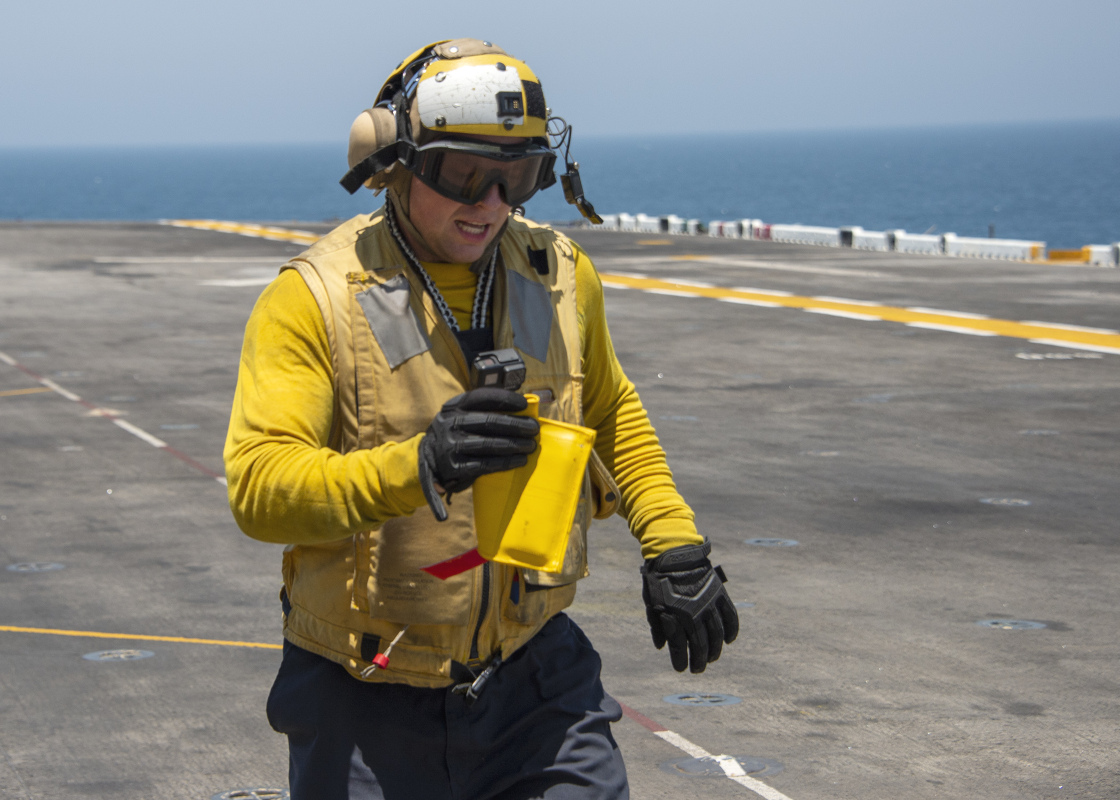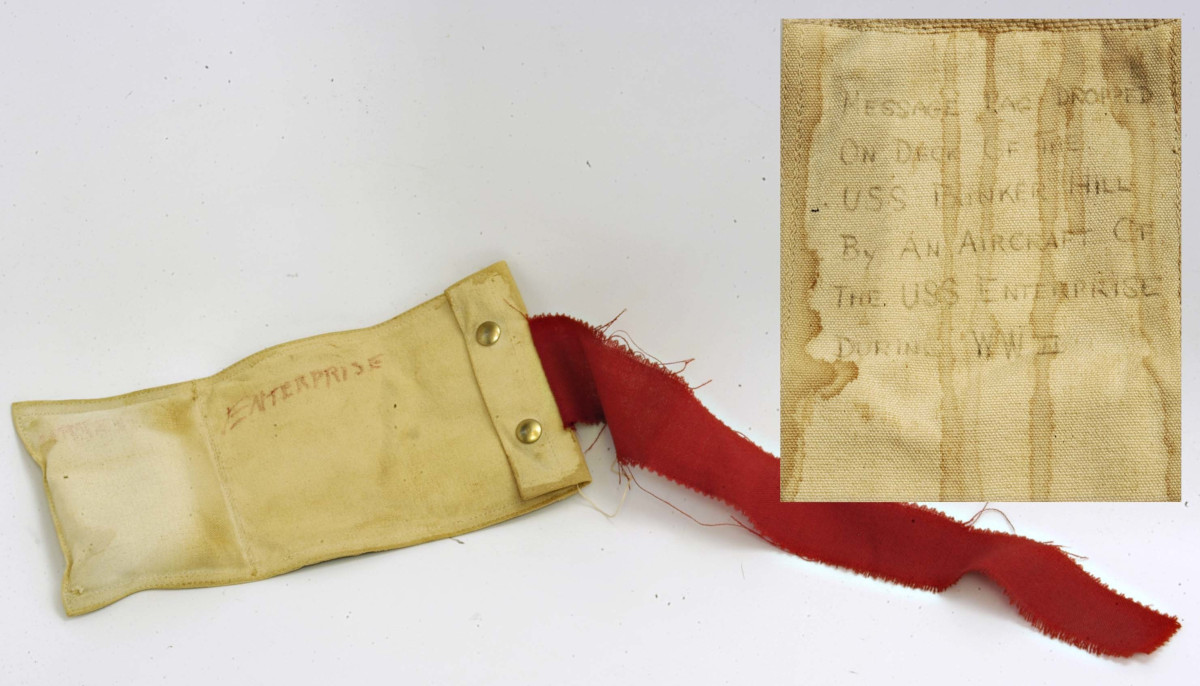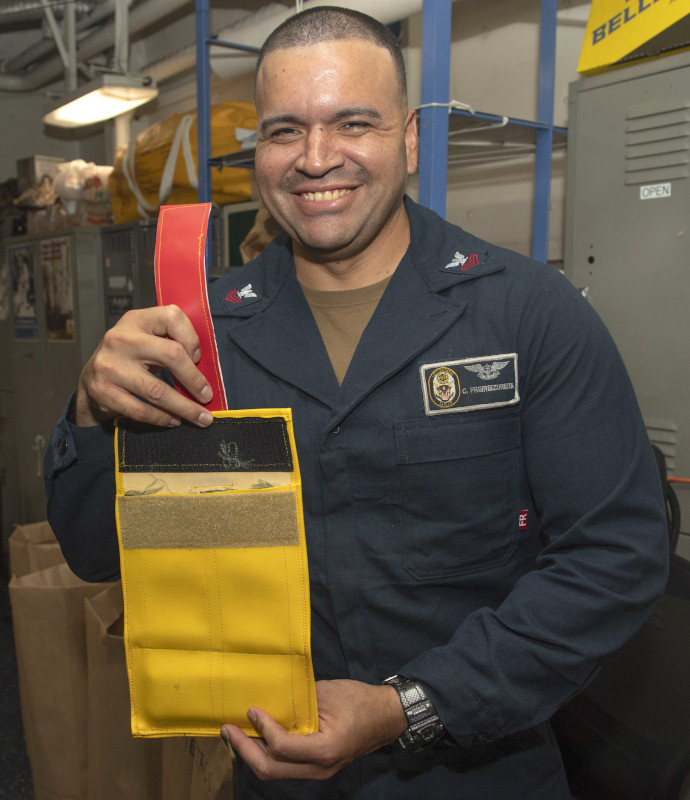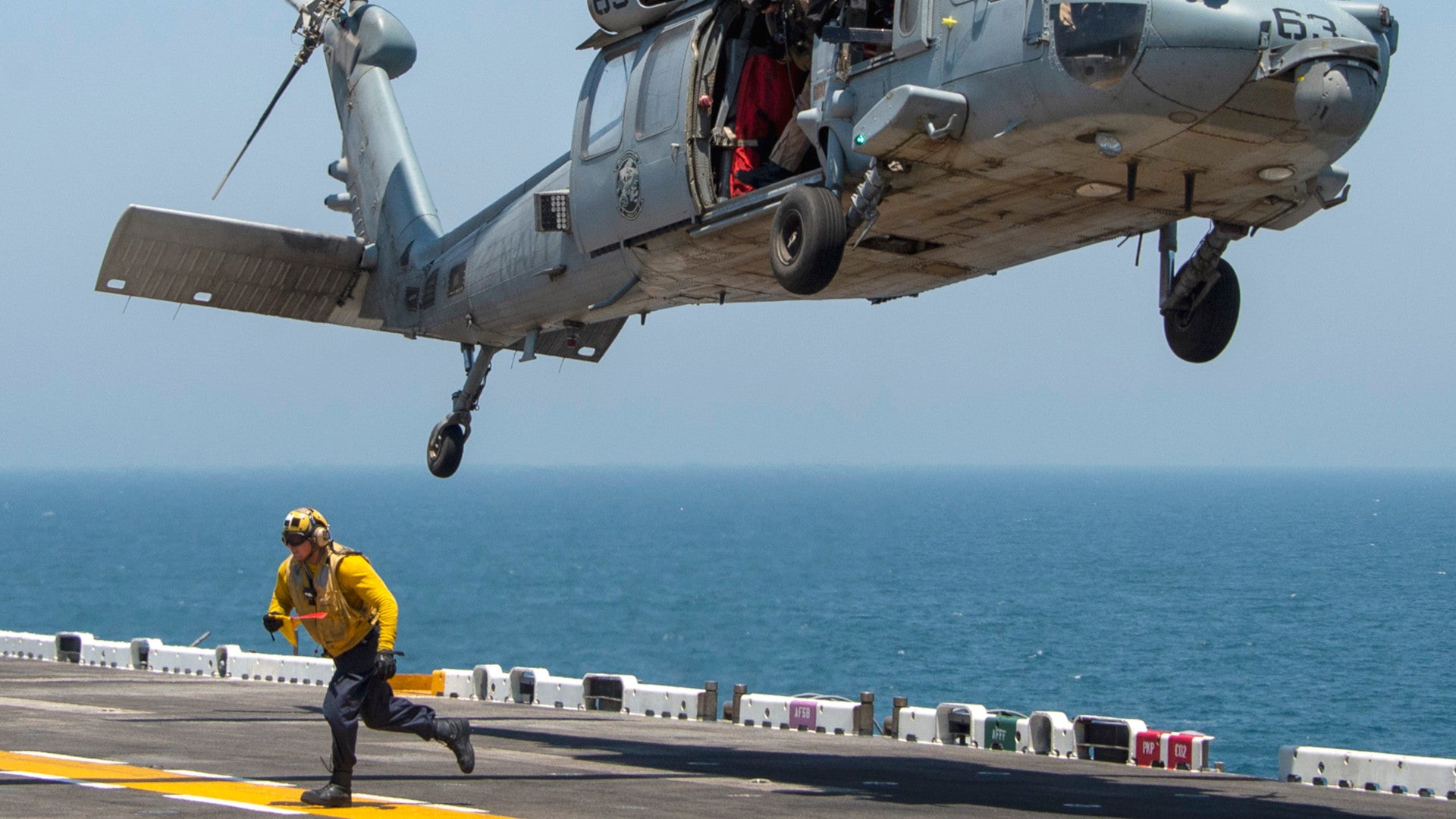Last month, sailors and Marines about the Wasp class amphibious assault ship USS Boxer brought down an Iranian drone with an electronic warfare attack after it got too close to the ship in the Strait of Hormuz, an incident that highlights a number of emerging trends in modern warfare. Now, personnel on the ship have had the opportunity to demonstrate how they might use messages tucked inside small bean bags, a concept dating back to World War II, to communicate in the midst of an electronic warfare attack or when it might be essential preserve radio silence to remain undetected.
On Aug. 4, 2019, an MH-60S Sea Hawk from Helicopter Sea Combat Squadron 21 (HSC-21) hovered above Boxer‘s deck and the helicopter’s crew tossed out a bright yellow pouch. A member of the ship’s deck crew retrieved it and quickly passed it up the chain of command until it arrived at its final destination, U.S. Captain Jason A. Burns, the Commander, Amphibious Squadron Five.
“The purpose of the bean-bag drop was to show timely pilot-to-ship communication can be done without electronic transmission,” U.S. Navy Lieutenant Commander Michael Brown, the officer in charge of HSC-21’s detachment onboard Boxer, said afterward. “Together HSC-21 crew and Boxer demonstrated timely communication from the aircraft to the ship during EMCON [emissions control] procedures.”
EMCON refers to the practice of limiting electromagnetic signatures, such as radio transmissions or radar waves, a ship emits, or “going radio silent.” A ship would do this to reduce the chances that an opponent would detect those emissions, which could give away their position. This would also prevent the enemy from intercept communications chatter or otherwise grabbing valuable electronic intelligence data. As noted, the bean bag messages could also be a useful tool if the ship’s communications systems were getting jammed or were otherwise inoperable.

The only problem with going radio silent, or getting jammed, of course, is that this limits the options available to transmit information, especially complex messages, rapidly even between ships sailing relatively close together. That’s where helicopters carrying orders and other missives in bean bags come in.
The idea dates back to the early days of World War II. In the immediate leadup to the famous Doolittle Raid on Japan in 1942, an SBD Dauntless dive bomber flying from the aircraft carrier USS Enterprise spotted a Japanese patrol boat ahead of the task force. Enterprise was part of the force escorting USS Hornet, which was carrying Doolittle’s Raiders and their B-25 bombers.
Fearing that the Japanese might get alerted if he radioed back, the SBD’s pilot flew low over Enterprise‘s deck and dropped a message attached to a bean bag onto the deck. As was the case on Boxer nearly 80 years later, sailors on the deck below rushed the message to the ship’s bridge so that the task force could take appropriate action to avoid patrol boat.
The bean bag message drop during the Doolittle Raid is seen in the archival video below at around 2:48 in the runtime.

“I started with the original measurements of the bean-bag used on the USS Enterprise in 1942 and built this one to withstand the impact of a drop but also weighed down for an accurate drop,” U.S. Navy Aircrew Survival Equipmentman 1st Class Carlos Freireizurieta, a member of Boxer’s Paraloft shop, explained. “The World War II bean-bags were filled with stuffing, but the one I made is weighted down with a one-pound steel bar sown into the bottom of the naugahyde [artificial leather] and webbing package.”


U.S. Navy Lieutenant Taryn “SISS” Steiger, who was the pilot of the MH-60S during the bean bag test drop on Boxer, noted that the helicopter might also be able to briefly land or use its hoist to pick up additional messages in return, as well. The Navy did not say how far the Sea Hawk flew during the test drop or how long the entire experiment took.
It’s not necessarily clear how practical the entire operation might be in a real-world situation. The information that the bean bag pouch could reasonably contain might be limited in both total volume and format. Written messages seem the most likely option, though the pouch could certainly carry flash drives or similar electronic storage devices to carry video or audio.
But, at the same time, having an alternative such as the bean bag readily available would certainly be better than nothing in a situation where it would be impossible or ill-advised to use more modern communications options. This method is certainly low tech and low cost making it easy enough to have available, if necessary. Other older technology, such as morse code via signal lights, and signal flags, also remains available, but they might not be able to transmit as much information as quickly as the bean bag and could be difficult to use in poor weather or heavy smoke or at night.
Whatever the case, the possibility of opponents spotting friendly forces from their electronic emissions, intercepting those transmissions, or just jamming them, are very real risks on the modern battlefield. On Aug. 7, 2019, the U.S. Department of Transportation’s Maritime Administration (MARAD) issued an advisory for commercial vessels sailing in the Persian Gulf, Strait of Hormuz, Gulf of Oman, Arabian Sea, and Red Sea – the same general areas where Boxer is operating – that warned about Iranian forces or their proxies jamming GPS signals and communications transmissions, as well as issuing confusing or false messages.

“In at least two … incidents, vessels reported GPS interference,” the advisory noted. “Vessels have also reported spoofed bridge-to-bridge communications from unknown entities falsely claiming to be U.S. or coalition warships.”
The risks, however, go far beyond Iran. Russia is widely believed to be the source of GPS jamming, in particular, in various locations in Europe and the Middle East, in recent years. America’s “great power” competitors are well aware of these issues, as well. For example, China recently announced it had brought back bugle calls as a battlefield communication tool.
All of this only underscores the increasing and dangerous possibility that U.S. forces might find themselves disconnected from electronic tools they’ve come to take for granted. The U.S. military has been exploring a variety of high- and low-tech solutions to this problem, ranging from things like installing new jamming resistant antennas on aircraft to reemphasizing training troops how to use compasses.
So, whether or not the Navy makes the bean bag message carrier a part of the standard communications suite on its larger warships, it is certainly an indication of how the service, along with the other branches of the U.S., are looking at all of their available options to ensure that personnel can communicate with each other quickly and effectively, no matter what.
Contact the author: joe@thedrive.com
